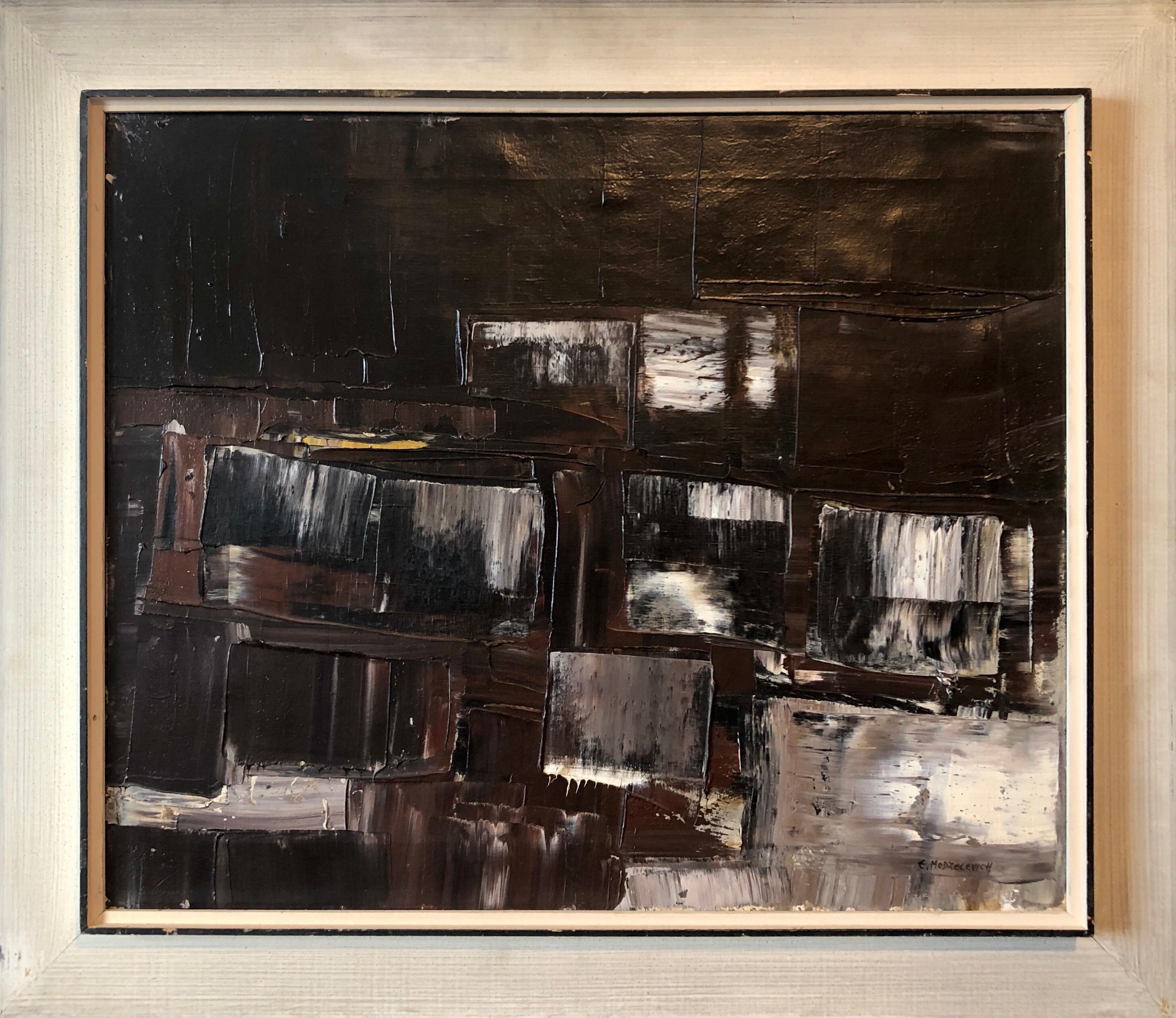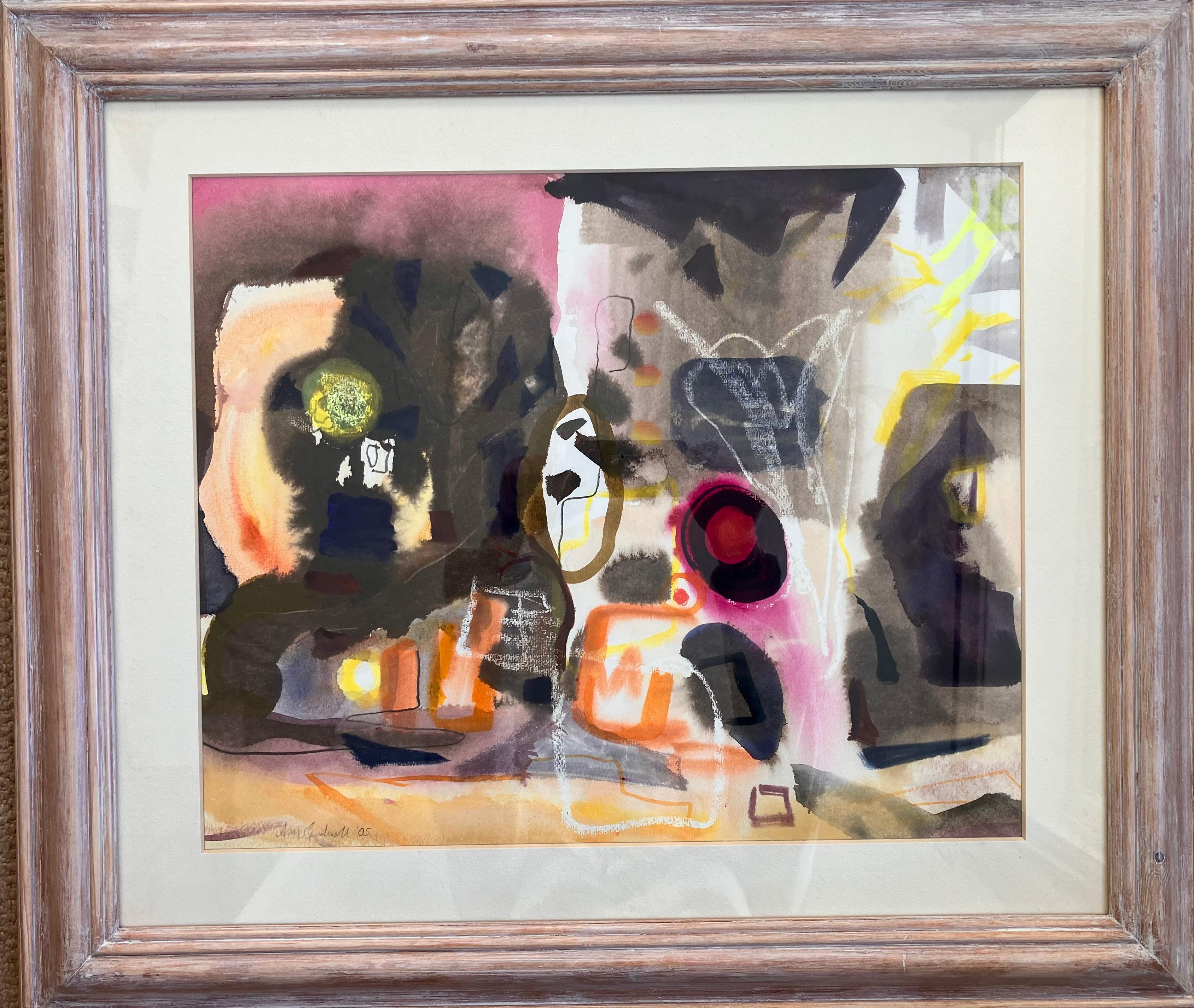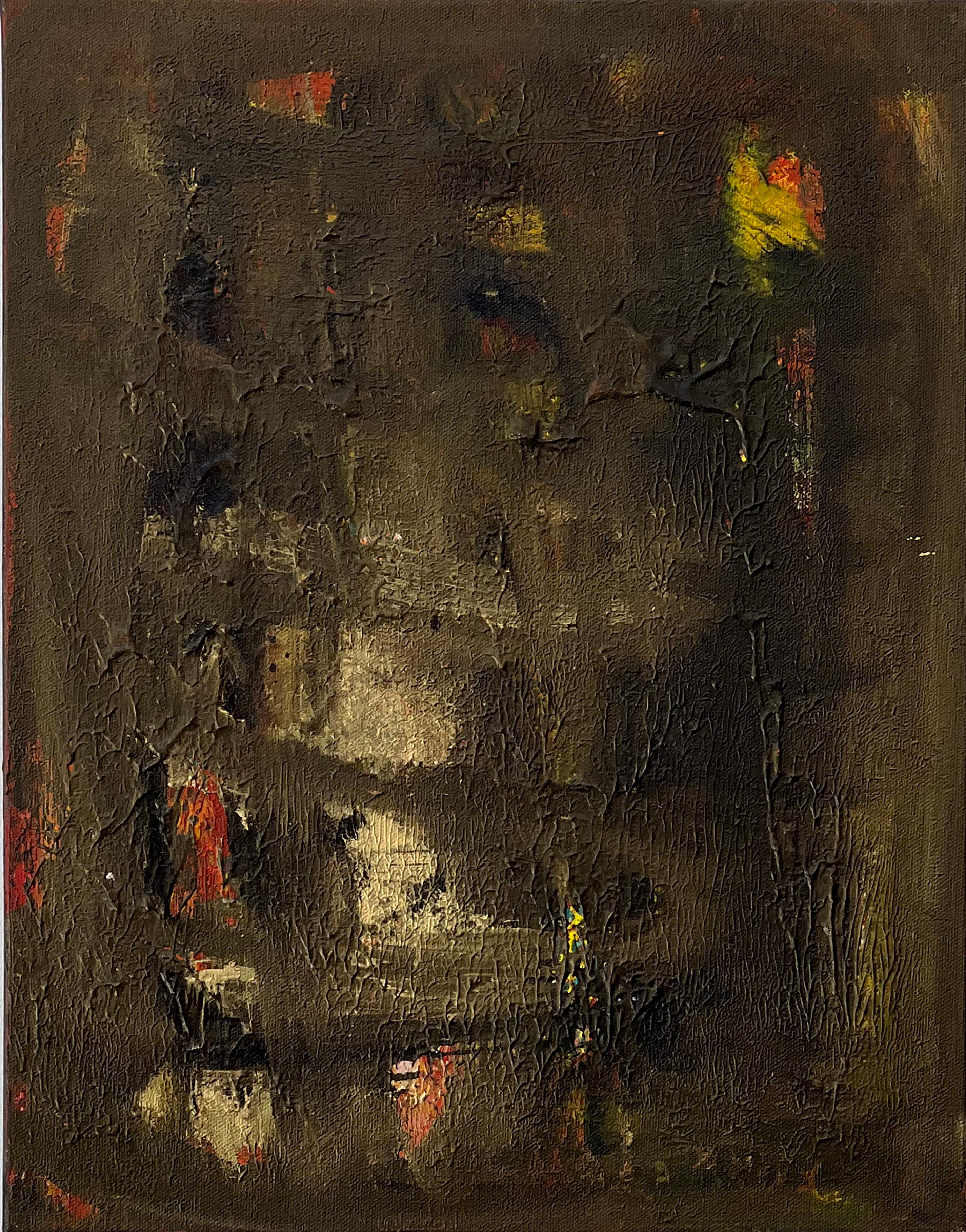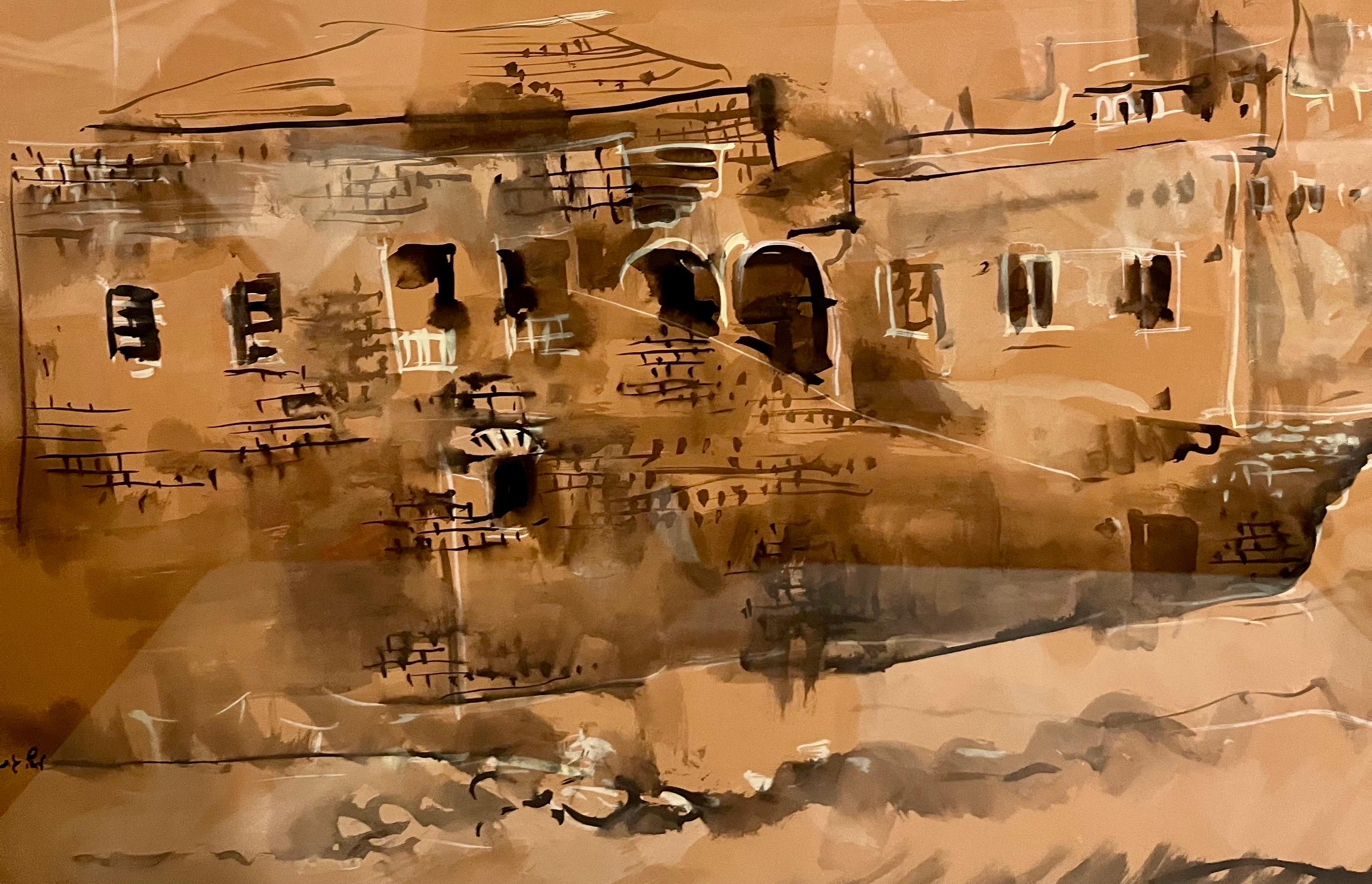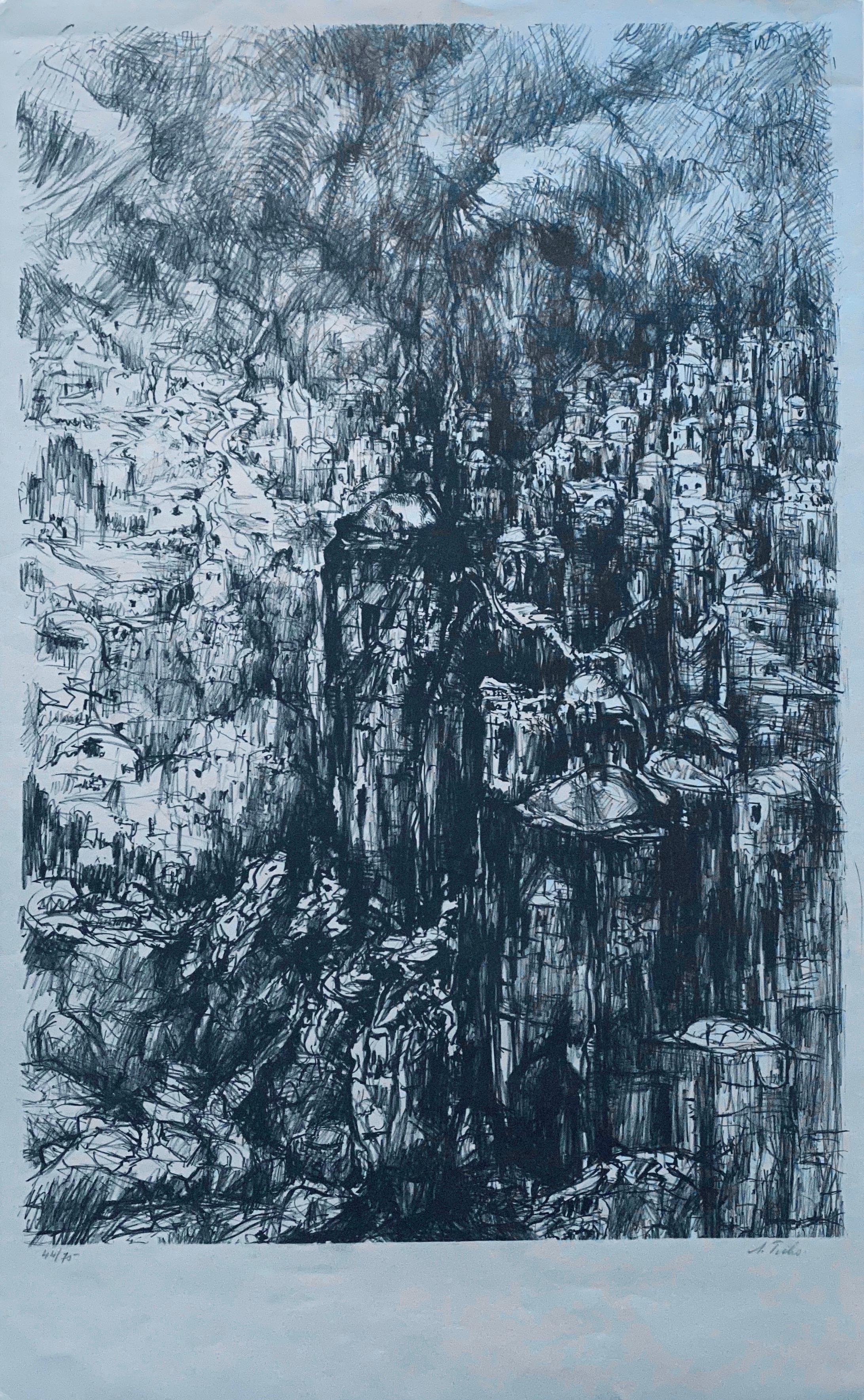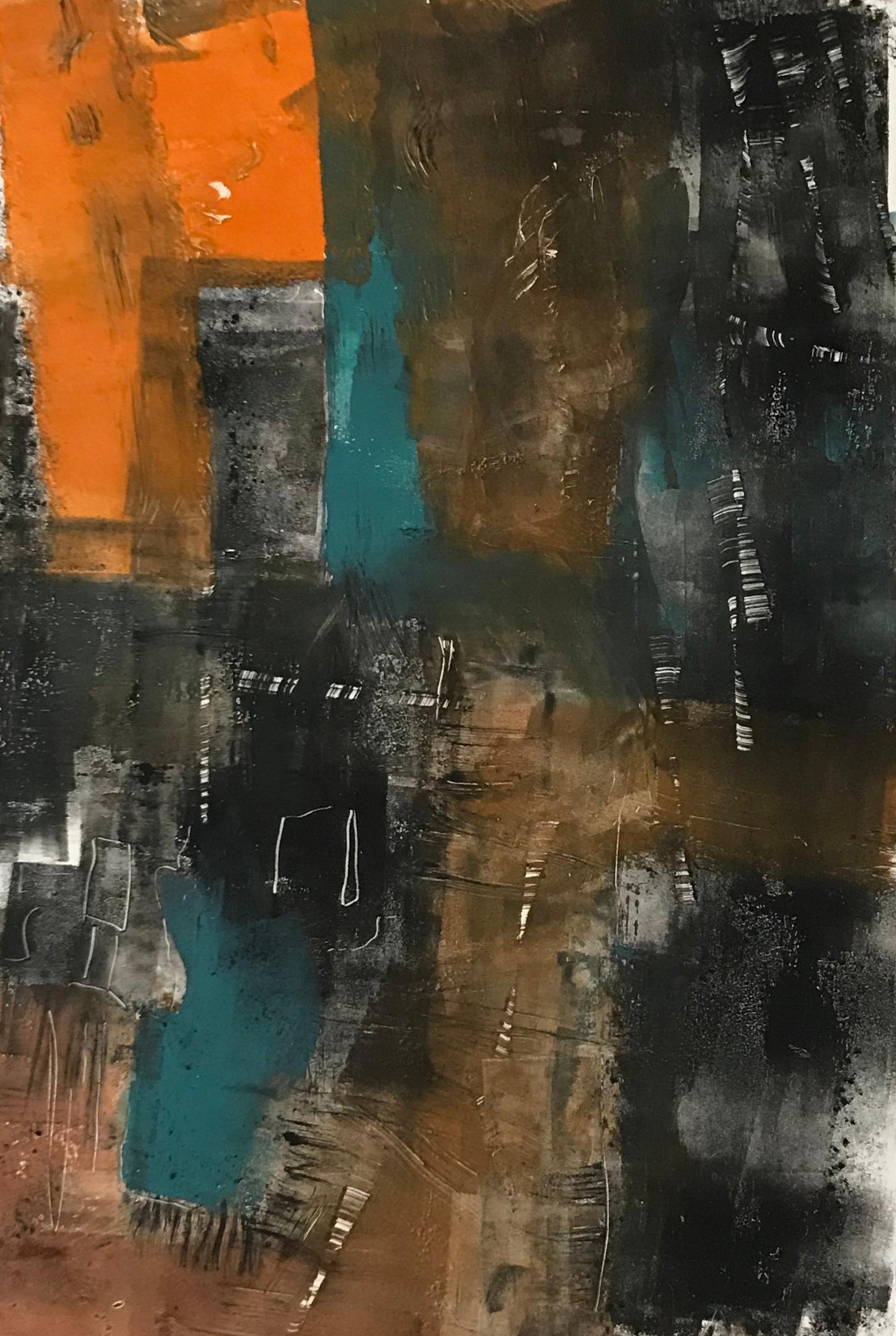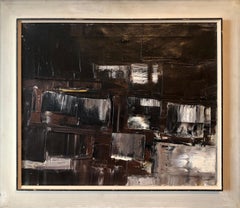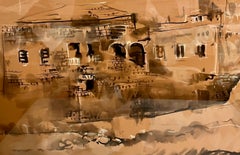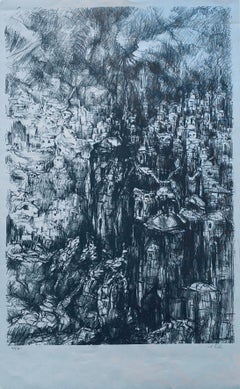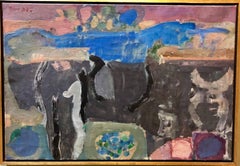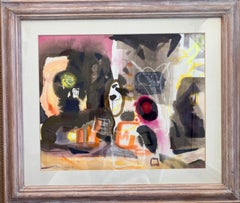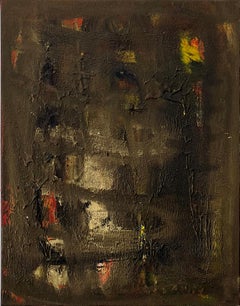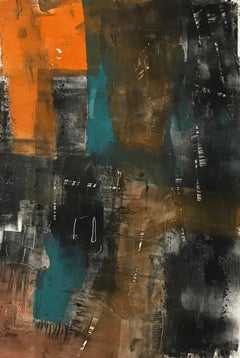Items Similar to Kibbutz Abstract Jerusalem Nightscape Israeli Tempera Collage Painting Judaica
Want more images or videos?
Request additional images or videos from the seller
1 of 12
Yitzhak GreenfieldKibbutz Abstract Jerusalem Nightscape Israeli Tempera Collage Painting Judaica1967
1967
$1,800
£1,366.78
€1,563.02
CA$2,514.86
A$2,797.07
CHF 1,460.55
MX$34,037.42
NOK 18,653.39
SEK 17,493.59
DKK 11,665.40
Shipping
Retrieving quote...The 1stDibs Promise:
Authenticity Guarantee,
Money-Back Guarantee,
24-Hour Cancellation
About the Item
Abstract Expressionist cityscape of Old City of Jerusalem in moody blues and gold. Yitzhak Greenfield, painter, born 1932, Brooklyn, New York His focus is on the heavenly and the terrestrial Jerusalem; on the Hebrew alphabet; and on central themes in Jewish tradition and culture. He deals with the tension between figurative and abstract.
Education
1946 Educational Alliance Art School, New York City, with Abba Ostrowsky, Chaim Gross, and Louis Lozowick.
1948 Thomas Jefferson High School, Brooklyn, New York, Art
1953 Drawing and Drawing Wall Murals,Seminar at Givat Haviva with P. Pelzig, Yohanan Simon, and Naftali Bezem.
1960 Printmaking with the artist and printmaker Borin, Venice, Italy
1979-1981 Morris Blackburn Print Workshop, New York City, U.S.A.
Teaching
Art Kibbutz Gal-On and Gat
1961-1963 Arts, regional school at Mateh-Yehuda
Regional school, Mate-Yehuda
Anglican school, Jerusalem
1965–70 Bet Ha'am, Popular University Outreach Program, Jerusalem
Ruth Youth Wing, Israel Museum, Jerusalem
Shira Mushkin: Majestic scenes in blue, gold and indigo, radiating spheres and grand expanses hover above architectural forms and clusters of Hebrew letters, revealing dreamlike realities. These are the creations of the artist Yitzhak Greenfield who works in watercolor and acrylic paints layered with collages of painted papers, discarded book materials, and fragments of his own prints. Applying parts of broken furniture, clock springs, iron locks and keys, the artist forms assemblages that hint at familiar settings, resonating the past. For Brooklyn born, Israeli artist Yitzhak Greenfield, these visions are the essence of the Jerusalem landscape, inspired by the city’s ever-changing magical scenery.
For generations, Jerusalem has been a focal point for the Jewish people. It is the center of Jewish life, faith, hope, history, and consciousness. Jerusalem holds a particular significance for Greenfield, who moved to Ein Kerem, Jerusalem over fifty years ago, after living on a kibbutz. Greenfield is a Jerusalem artist, and he remarks: “Living and working in Jerusalem is a special journey for me. My works are visionary landscapes, which are reconstructions of Jerusalem, not always relating to specific sites.” The artist has always been intrigued by the historical and dynamic nature of the city, as he constantly explores his own connection to the traditional and spiritual forms of Judaism. Greenfield’s art is linked to Jewish and Israeli history and symbols, such as the Hebrew letters, Jewish amulets, and the Ten Sephirot (Kabbalah emanations), containing aesthetic qualities of the material and the spiritual.
Working in a distinctive modernist method, Greenfield’s artwork lends itself to rich possibilities of expression. The exhibition Yitzhak Greenfield: Exploring Jerusalem comprises three main series from the artist’s career, which span over the course of many years and continue to this day; Jerusalem Visions, Jerusalem Assemblages, and Landscape and Meditation on the Hebrew Letter. These artworks portray timeless dream-landscapes of Jerusalem. The hidden secrets of the city are locked away in assemblage constructions, and prints depicting Hebrew letters illuminate into mystical meanings. The spectator travels along with Greenfield through his creations, exploring Jerusalem and experiencing a spiritual and living Judaism, in which the artist constantly searches for the expression of his cultural and spiritual legacy as he reconstructs Jerusalem.
1966 General Exhibition - Jerusalem Artists' House
Artists: Hirszenberg, Samuel Boris Schatz, Lilien, Ephraim Moses, Joseph Budko, Leopold Krakauer, Meir Gur Arie, Jacob Eisenberg, Ben Zvi, Zeev Palombo, David Ofek, Avraham Elnathan, Moshe, Ardon, Mordecai Aroch, Arie Arikha, Avigdor Aschheim, Isidor Blum, Ludwig Blum, Motke (Mordechai) Bezalel, Aharon, Greenfield, Yitzhak Hirsch, Joseph Jean David, Anna Ticho, Moshe Tamir, Levanon, Mordechai Litvinovsky, Pinchas, Fima (Roytenberg, Ephraim) Pins, Jacob Steinhardt, Jakob Stern, Yossi Schatz, Bezalel (Lilik) Schatz, Louise.
Awards And Prizes
1948 Excellence Award in Art, Jefferson High School, Brooklyn, New York, U.S.A.
1956 Dizengoff Prize, Tel Aviv Museum of Art, Tel Aviv
1956 Association for Jewish Art in Jerusalem, Prize for Jewish Art,
1960 The America-Israel Cultural Fund Scholarship
1983 Award for the painting "Jerusalem", Association for Jewish Culture, Jerusalem
- Creator:Yitzhak Greenfield (1932)
- Creation Year:1967
- Dimensions:Height: 18.38 in (46.69 cm)Width: 13 in (33.02 cm)
- Medium:
- Movement & Style:
- Period:
- Condition:good. please see photos.
- Gallery Location:Surfside, FL
- Reference Number:1stDibs: LU38215488922
About the Seller
4.9
Platinum Seller
Premium sellers with a 4.7+ rating and 24-hour response times
Established in 1995
1stDibs seller since 2014
1,784 sales on 1stDibs
Typical response time: <1 hour
- ShippingRetrieving quote...Shipping from: Surfside, FL
- Return Policy
Authenticity Guarantee
In the unlikely event there’s an issue with an item’s authenticity, contact us within 1 year for a full refund. DetailsMoney-Back Guarantee
If your item is not as described, is damaged in transit, or does not arrive, contact us within 7 days for a full refund. Details24-Hour Cancellation
You have a 24-hour grace period in which to reconsider your purchase, with no questions asked.Vetted Professional Sellers
Our world-class sellers must adhere to strict standards for service and quality, maintaining the integrity of our listings.Price-Match Guarantee
If you find that a seller listed the same item for a lower price elsewhere, we’ll match it.Trusted Global Delivery
Our best-in-class carrier network provides specialized shipping options worldwide, including custom delivery.More From This Seller
View AllIsraeli Modernist Abstract Expressionist Jerusalem Kotel Oil Painting Judaica
By Efraim Modzelevich
Located in Surfside, FL
Efraim Modzelevich (1931-1995) Work is abstract in subject, and expressive in terms of technique. The artist uses a muted color palette, and thick layers of paint to build up his co...
Category
Mid-20th Century Modern Abstract Paintings
Materials
Canvas, Oil
Large Israeli Watercolor Gouache Painting Jerusalem Landscape Moshe Gat
By Moshe Gat
Located in Surfside, FL
A signed watercolor gouache painting in frame.
Framed: 26.5 X 32.5
Image: 19 X 25
Moshe Gat was born in Haifa in 1935.
in 1952 he began his studies at the Bezalel School, in Jeru...
Category
Mid-20th Century Expressionist Figurative Drawings and Watercolors
Materials
Watercolor, Gouache
German Israeli Expressionist Abstract Lithograph Of Jerusalem Landscape
By Anna Ticho
Located in Surfside, FL
Anna Ticho (אנה טיכו ) (1894-1980) was a Jewish artist who became famous for her drawings of the Jerusalem hills.
Anna Ticho was born in Brno, Moravia, then part of the Austro-Hungarian Empire (today the Czech Republic) in 1894. At the age of 15, she began to study drawing in Vienna in an art school under the directorship of Ernst Nowak...
Category
20th Century Expressionist Landscape Prints
Materials
Lithograph
Lyrical Abstract Israeli Expressionist Oil Painting
By Hanna Ben Dov
Located in Surfside, FL
Hanna Ben Dov is an Israeli abstract painter who was born in Jerusalem in 1919 and died in Paris in 2008.
Ben Dov's father, Yacov Ben-Dov, was a famous Israeli photographer who founded the photography department in the Bezalel Academy of Art and Design in 1910. Hannah herself attended Bezalel during the 1940s, and later continued to Camberwell College of Arts in London. After the completion of her formal education she moved to Paris, where she exhibited for the first time in 1948 and has been living and working there since, as a part of the local abstract artists school. She took part in the first French Biennale of 1951, that was held in Menton.
Collections
Her paintings can be found in several collections, including the French State Collection, the Tel Aviv Museum of Art collection, the Bezalel National Museum collection in Jerusalem and the Rockefeller Museum collection in New York.
Ben Dov resided for her last two years at the Maison Des Artistes Home in Nogent-Sur-Marne, France, just outside Paris.
Exhibitions
Gallery97 Tel Aviv Paintings...
Category
20th Century Modern Landscape Paintings
Materials
Canvas, Oil
Israeli Motke Blum Modernist Abstract Expressionist Oil Painting Bezalel Artist
By Motke Blum
Located in Surfside, FL
Motke Blum was born in Racacun, Romania in 1925. Early in his childhood, the Blum family moved to Bucharest where they settled in a house situated near a circus. The circus would become young Blum's greatest love. He befriended several of the clowns and other performers and, when not painting or playing in clay, Blum could be found enjoying the company of these spirited entertainers. These experiences would later become a recurring theme in many of his works of art.
In 1938, he was taken by the Romanian Iron Guard. When the Germans invaded Romania, Blum was taken to a forced labor camp. Even during his imprisonment, he continued to create art, painting on the walls of the camp. He escaped the Nazi camp in 1944 and boarded an immigrants' ship to Israel. One of the three ships in the convoy was sunk by a German torpedo. Motke later incorporated shipwrecks, boats, and other maritime subjects into several of his paintings.
Studies, Bezalel, Jerusalem, Enamel, Silversmithing, Painting and Sculpture.
1956 Seminar in the dep. of design in the royal silver factory of Zeist, The Netherlands.
Over the course of his long and fruitful career, Blum showed internationally at over fifty one-man-shows with exhibits in Israel, Holland, England, Belgium, the United States, France, Australia, and more. His art has been commissioned for public buildings and by prominent figures in Israel and around the world, and a series of posters were commissioned by the Justice Ministry and the Ministry of Tourism.
Group exhibition
Rina Gallery, Jerusalem
Artists: Motke Blum, Efraim Fima (Roytenberg, Ephraim) Zelig Segal, David Sharir, Joseph Halevi...
Category
20th Century Modern Abstract Paintings
Materials
Mixed Media, Oil, Illustration Board
Abstract Israeli Landscape Jay Milder Rhino Horn Painting Jaffa, Israel Pop Art
By Jay Milder
Located in Surfside, FL
This came from the collection of the Horace Richter Gallery
These were done in the 1990's
Hand signed and dated by the artist. Old Jaffa
Jay Milder (born 1934) is an American artist and a figurative expressionist painter of the second generation New York School. Old Testament themes such as Jacob's Ladder and Noah’s Ark, and the Jewish mystical beliefs of the Kabbalah, are recurring themes in Milder’s paintings which are presented as archetypal images that recur in the basic karma, make-up and need of human nature. Internationally exhibited, Milder is included in the collections of many national and international museums.
He has been the subject of two, recent retrospectives in Brazil in 2007 at the National Museum Brasilia and, in 2006, at the Museum of Modern Art, in Rio de Janeiro. He is renowned in Sao Paulo, one of the major international centers for street and public art, as a seminal influence on graffiti artists. Jay Milder was born in Omaha, Nebraska, in 1934. His grandparents, who came from the Ukraine, were descendants of the Hasidic mystic, Rabbi Nachman. As he listened to family stories his interest in spiritualism and mysticism increased, and became an important influence on his philosophy of life and art. Later, when he arrived in New York, he was drawn to the Theosophical Society and the teaching of Helena Blavatsky.
In 1954 Milder visited Europe where he studied painting with André L’Hote, and sculpture with Ossip Zadkine. He spent much time studying at the Louvre Museum, and at the studio of Stanley Hayter. During his Paris years the paintings of the Jewish painter Chaim Soutine, primarily influenced him. Milder returned to the United States in 1956, and he began studying painting at the Chicago Art Institute. He exhibited with the Momentum Group, an alliance of artists who were particularly dedicated to the progression of figurative art and its global origins.
In 1957, Milder spent the summer in Mexico for a summer where he exhibited in Puebla. That year he received the Mexican Government’s Honor Award for artists.
In the summer of 1958, Milder studied with Hans Hofmann in Provincetown, Massachusetts. He exhibited his work at the Sun Gallery, with his contemporaries, including Mary Frank, Red Grooms, Bob Thompson...
Category
20th Century Abstract Expressionist Abstract Paintings
Materials
Paper, Gouache
You May Also Like
'Ravello Night' original mixed media painting circa 2005 . signed original .
Located in Frome, Somerset
Ravello , Italy . Evening Scape of sights and sounds. Painted plein air in the Piazza. His manner is about recording the dimensions of colour and form and their possibilities. Grad...
Category
Early 2000s Abstract Expressionist Abstract Paintings
Materials
Mixed Media
Night in the Woods - acrylic on canvas
Located in West Hollywood, CA
Nina is an artist, ceramist and colorist with 20 years of professional experience and a lifetime of art appreciation. Originally from Virginia and having traveled and lived extensively worldwide she now resides as a full-time artist and ceramist in Los Angeles.
With a degree in psychology and training in ceramics, painting was a natural transition and expansion to her repertoire from an early age. With color and form as her guide, her artwork flows from spontaneous and spiritual inspiration. Influenced by her travels with the play of color and light, her paintings reflect nature, spirit and a place of tranquility. There’s a touch of magic, secrets and a touch of the unknown in every painting, when painting ”time...
Category
2010s Abstract Abstract Paintings
Materials
Canvas, Acrylic
Night Walk, abstract
By Mary Chang
Located in Brooklyn, NY
Monotype Charbonnel Ink Archival paper
Category
2010s Abstract Expressionist Abstract Drawings and Watercolors
Materials
Archival Ink, Archival Paper, Monotype
Judaica Oil Painting By Shmuel Brand
By Shmuel Brand
Located in Long Island City, NY
Artist: Shmuel Brand, German/Israeli (1921 - )
Title: Untitled
Year: 1980
Medium: Oil with Mixed Media on Masonite, signed l.l
Size: 39.5 x 27.5 in. (100.33 x 69.85 cm)
Category
1980s Abstract Abstract Paintings
Materials
Masonite, Oil
The Night and the Weft, Abstract Painting
Located in San Francisco, CA
Artist Comments
Artist Roman Antopolsky demonstrates a gestural abstract with elements of minimalism. Blocks of color permeate the division of...
Category
21st Century and Contemporary Abstract Mixed Media
Materials
Mixed Media
Israeli Contemporary Art by Dondi Schwartz - Colonializm Abstract
Located in Paris, IDF
Oil on canvas
Category
2010s Contemporary Figurative Paintings
Materials
Oil, Canvas
$720 Sale Price
20% Off
